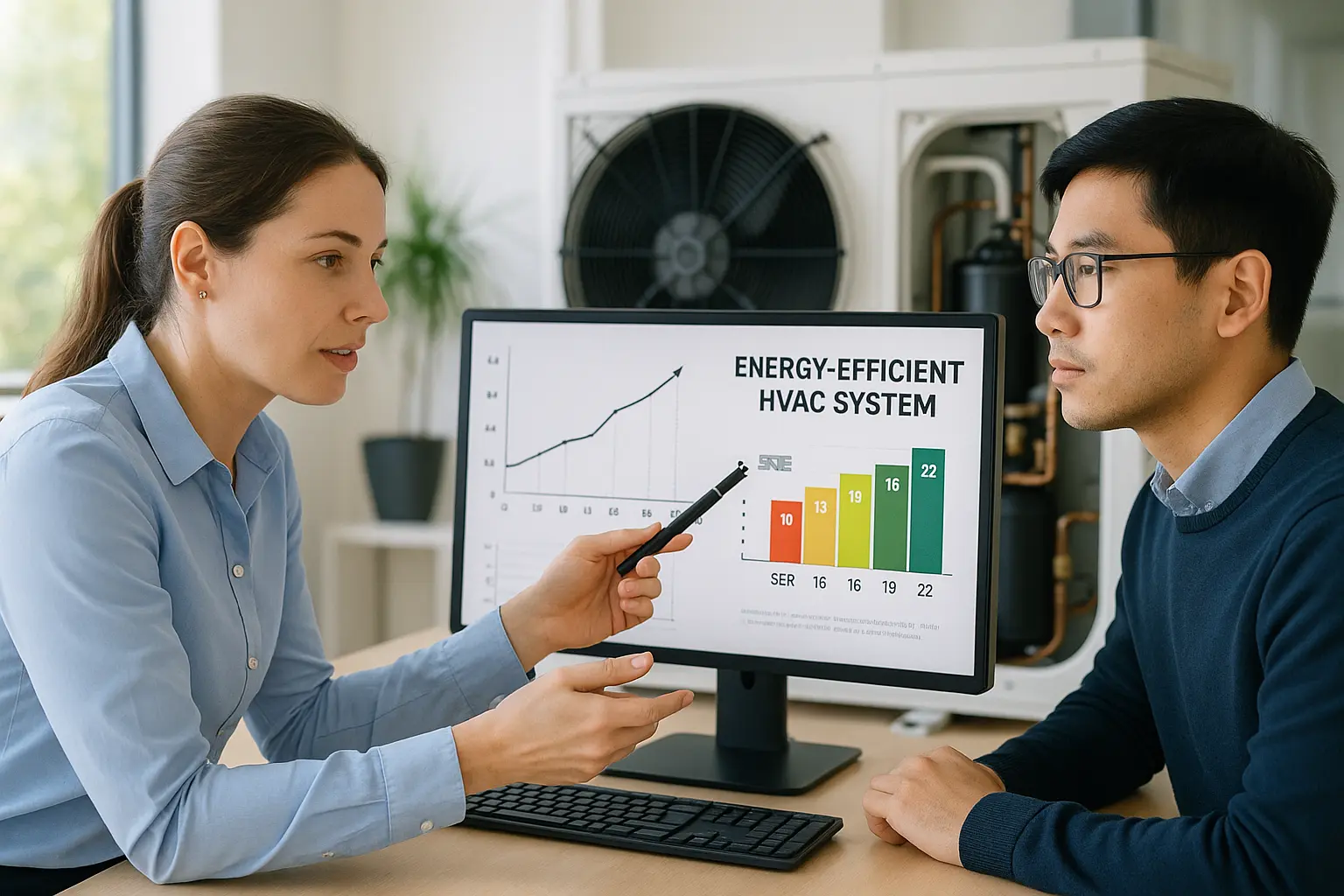Introduction
Navigating home energy topics can feel overwhelming, especially when you encounter terms like “SEER rating” in conversations about air conditioning and heating. Many homeowners struggle to connect the technical details with real-life improvements in comfort and cost. Whether you’re looking to upgrade your cooling system for better performance or you want to trim your bills, understanding how things work can make all the difference. In this article, we’ll break down the idea of SEER ratings, explore practical examples, and explain why these ratings matter from financial and environmental viewpoints. Along the way, we’ll also discuss how achieving Smart Cooling Efficiency can transform your home life.
Smart Cooling Efficiency: A New Perspective
When it comes to home cooling, achieving Smart Cooling Efficiency means not only using fewer resources but also enjoying a more comfortable indoor environment. Homeowners increasingly look for options that combine reduced energy use with high performance, and this concept ties in naturally with the SEER rating. In this guide, you’ll discover how the principles behind Smart Cooling Efficiency are integrated into modern air conditioning systems and what that means for your energy bills and indoor comfort.
What is a SEER Rating?
Defining the Concept
The abbreviation SEER stands for Seasonal Energy Efficiency Ratio. This numerical measure is used mainly to rate air conditioners, heat pumps, and similar cooling units. In simple terms, the SEER rating shows how much cooling a system delivers per unit of energy over an entire cooling season. When you see higher SEER numbers, it tells you that the unit uses less electrical power to cool your home. This forms the bedrock of Smart Cooling Efficiency, as better efficiency naturally lowers energy use.
For example, comparing two air conditioners with ratings of 16 and 14 SEER shows that the unit with 16 SEER cools more effectively while using fewer kilowatt-hours. This approach not only cuts down on your monthly bills but also helps pave the way for a more sustainable future. Incorporating SEER ratings into your purchase decisions means you are directly supporting practices that promote Smart Cooling Efficiency in your household.
Smart Cooling Efficiency in Action
Manufacturers determine the SEER rating by dividing the total cooling provided by the electrical energy consumed during a typical season. Imagine an air conditioner that consumes 1,000 kilowatt-hours (kWh) during the cooling period; its total cooling output—measured in BTUs (British Thermal Units)—divided by that energy use gives you the SEER score. While the math may seem a bit technical, think of it as a shortcut to understanding how well your system converts electricity into cool air.
The standardized testing environments for these units ensure that the SEER ratings are reliable. This consistency allows home buyers to make straightforward comparisons between different models while keeping in mind that each unit is designed to meet specific efficiency benchmarks. Whether you’re checking the specifications or comparing models, realizing the impact of these numbers can lead to significant energy savings, reinforcing the idea behind Smart Cooling Efficiency.
Different Rating Standards
SEER rating guidelines can vary from region to region, influenced by local weather and government regulations. In the United States, for instance, federal rules set different minimum SEER standards depending on the climate. In the warmer southern states, central air conditioners often need to meet a minimum SEER of 14, while in cooler northern climates a rating of 13 might be sufficient. This regional differentiation helps ensure that all cooling systems perform well under their typical operating conditions.
These varying standards reflect a balance between energy conservation and actual cooling needs. In hotter areas, a higher minimum SEER rating means systems can continuously run without guzzling power, which is crucial when aiming for Smart Cooling Efficiency. Local codes also guide manufacturers as they design new products, ensuring that each unit contributes to lower operating costs and a smaller environmental footprint over time.
By understanding these standards, consumers gain the insight necessary to choose systems that not only meet regulatory requirements but also help maximize overall efficiency, pushing forward the idea of Smart Cooling Efficiency in everyday living.
Why SEER Rating Matters
Financial Implications
Opting for a higher SEER rating frequently translates to substantial savings on your energy bills. Investing in air conditioning systems with elevated SEER numbers may cost more initially, but the payoff comes in the form of lower monthly expenses. When your unit operates more efficiently, every unit of power goes further, reducing your energy use and supporting Smart Cooling Efficiency overall.
Take, for instance, a home in a region where summer days extend for many months. A high-rated system means your costs remain stable, and you avoid wild swings in your utility bills. Studies show that over a typical lifespan of 15 to 20 years, the savings on electric bills can more than offset the added upfront expense. This long-term fiscal advantage is a core reason many homeowners target Smart Cooling Efficiency when choosing their systems.
Additionally, financial incentives from various government and utility programs can further reduce the net cost. When rebates and tax incentives come into play, your path to Smart Cooling Efficiency becomes not only environmentally savvy but also economically attractive. These incentives highlight how energy savings can ultimately lead to a healthier bottom line.
Environmental Impact
Another significant benefit of choosing systems with high SEER ratings is their positive effect on the environment. Because energy-efficient systems draw less power, they reduce greenhouse gas emissions—a key factor in combating climate change. In essence, each step you take toward Smart Cooling Efficiency helps cut down on harmful pollutants.
Homeowners adopting high-performance cooling models contribute to a broader push for environmental sustainability. When entire neighborhoods update to efficient units, the cumulative effect on reducing demand at local power plants is striking. Thanks to these savings, there’s less strain on our energy grid and a tangible drop in emissions like carbon dioxide and methane. This environmental win encourages more people to pursue Smart Cooling Efficiency in their homes.
Local policies and green initiatives often reward those who choose energy-efficient technologies, making it both an ecologically responsible and cost-effective decision. By selecting units that promote Smart Cooling Efficiency, you play a part in driving a movement toward a more sustainable future.
Enhancing Indoor Comfort
Beyond the dollars and environmental gains, higher SEER ratings lead to a noticeable boost in home comfort. Modern cooling systems are equipped with technologies that support precise humidity control and even temperature distribution. This consistent indoor climate is central to the promise of Smart Cooling Efficiency—less fluctuation in temperature means quieter, more comfortable living conditions.
For example, many efficient units now come with variable-speed compressors and smart thermostat settings. Instead of a simple on/off mechanism, these systems adjust their output gradually, fitting perfectly with the goals of Smart Cooling Efficiency. The end result is a home where the air is not only cooler but cleaner, thanks to advanced filters that remove dust and allergens.
Better indoor air quality can make a substantial difference—especially for those with respiratory concerns. The advantages of these modern, efficient cooling systems extend beyond lower bills; they cover overall well-being, showcasing the complete picture of Smart Cooling Efficiency in everyday life.
Choosing the Right SEER Rating
Assessing Personal Needs
Choosing a cooling system tailored for your home starts with a close look at your own needs. Consider how often your air conditioner will run and the kind of weather conditions you face daily. In hotter or more humid climates, the benefits of a highly efficient unit become more apparent, especially when aiming for Smart Cooling Efficiency. Homes with larger spaces or multiple temperature zones may also require a unit with a higher SEER rating.
Factors like home size, insulation quality, and usage patterns all contribute to the decision. Detailed energy audits can offer insight into the specific cooling requirements needed to achieve Smart Cooling Efficiency. It’s about finding the right balance—whether you opt for steady operation, quiet performance, or enhanced humidity control, the ideal unit is the one that fits seamlessly into your lifestyle.
Individual preferences also influence the choice. Some homeowners might favor an ultra-quiet operation, while others might focus on features that boost air quality. Keeping these priorities in mind will guide you toward the cooling system that supports your journey to Smart Cooling Efficiency.
Budgeting Effectively
Budget planning plays an essential role when selecting a new air conditioning system. It is tempting to opt for the most advanced model, but practicality is key. Evaluating long-term savings against the initial cost is a smart strategy. A unit with a higher SEER rating might cost more up front, but reduced energy consumption can significantly cut monthly bills, a core benefit of Smart Cooling Efficiency.
Understanding lifetime operating costs is crucial. A cost-benefit analysis shows that while the efficient model demands a bigger seed investment, recurring energy savings can pay for that difference quickly. Many utilities even offer rebates or financing options, easing the move toward these advanced systems. These factors make it easier to achieve Smart Cooling Efficiency without compromising your budget.
Sometimes, a mid-range SEER rating is just right if your area experiences milder summers. Be sure to include maintenance and repair expenses in your planning. With comprehensive evaluations and a clear focus on Smart Cooling Efficiency, you can pick a system that fits both your financial plan and cooling requirements.
Consulting HVAC Experts
When it comes to high-stakes decisions like choosing an air conditioning system, the insights of skilled HVAC professionals are invaluable. These experts understand every nuance of SEER ratings and how they tie into Smart Cooling Efficiency at home. They consider many factors—such as your home’s layout, insulation quality, and local climate—to recommend the best choice.
HVAC professionals carry out thorough assessments, suggesting optimal system sizes and configurations to match your energy needs. By consulting these specialists, you tap into a wealth of knowledge that can safeguard your investment and promote long-term Smart Cooling Efficiency. Their technical advice ensures you select a system that not only cools effectively but does so with minimal energy waste.
Their awareness of the latest trends, including improvements in smart thermostats and zoned cooling, means you benefit from the most current features. This alignment with Smart Cooling Efficiency helps you navigate installation details and local regulations with ease, making your transition to a more efficient cooling system smoother.
In short, getting professional advice from trusted HVAC experts is a wise move if you want your home to realize the full promise of Smart Cooling Efficiency while keeping energy consumption in check.
Conclusion
Grasping the ins and outs of SEER ratings is a key step on the road to a more energy-conscious home. When you understand how SEER ratings work, how they’re measured, and why they matter, you’re in a better position to make choices that support both your wallet and the planet. Upgrading to high-efficiency systems, despite the higher upfront cost, means reaping long-term savings, better air quality, and a clear stride toward reducing greenhouse emissions.
In essence, selecting the right SEER rating is about matching your lifestyle and budget while embracing expert advice. Whether it’s lowering your energy bills or ensuring year-round comfort, every smart choice aligns with the core ideas of Smart Cooling Efficiency in your home. By considering your usage patterns, consulting knowledgeable professionals, and thoughtfully comparing system specifications, you can find the ideal air conditioning or heat pump solution that meets your needs.
For those ready to invest in home cooling technology, it pays to weigh every factor from performance to cost. Your path to a more efficient and comfortable environment starts with understanding these key metrics and the broader goal of Smart Cooling Efficiency. In the long run, every decision you make not only enhances your quality of life but also contributes to a healthier planet through improved energy savings and reduced cooling costs.
As new technologies emerge and the push for greener alternatives intensifies, staying informed and proactive about energy efficiency is more important than ever. Explore your options, compare systems carefully, and remember that achieving Smart Cooling Efficiency is a decision that benefits your home, your finances, and our world. Choose wisely, and enjoy the cool, efficient comfort every room in your house deserves.





